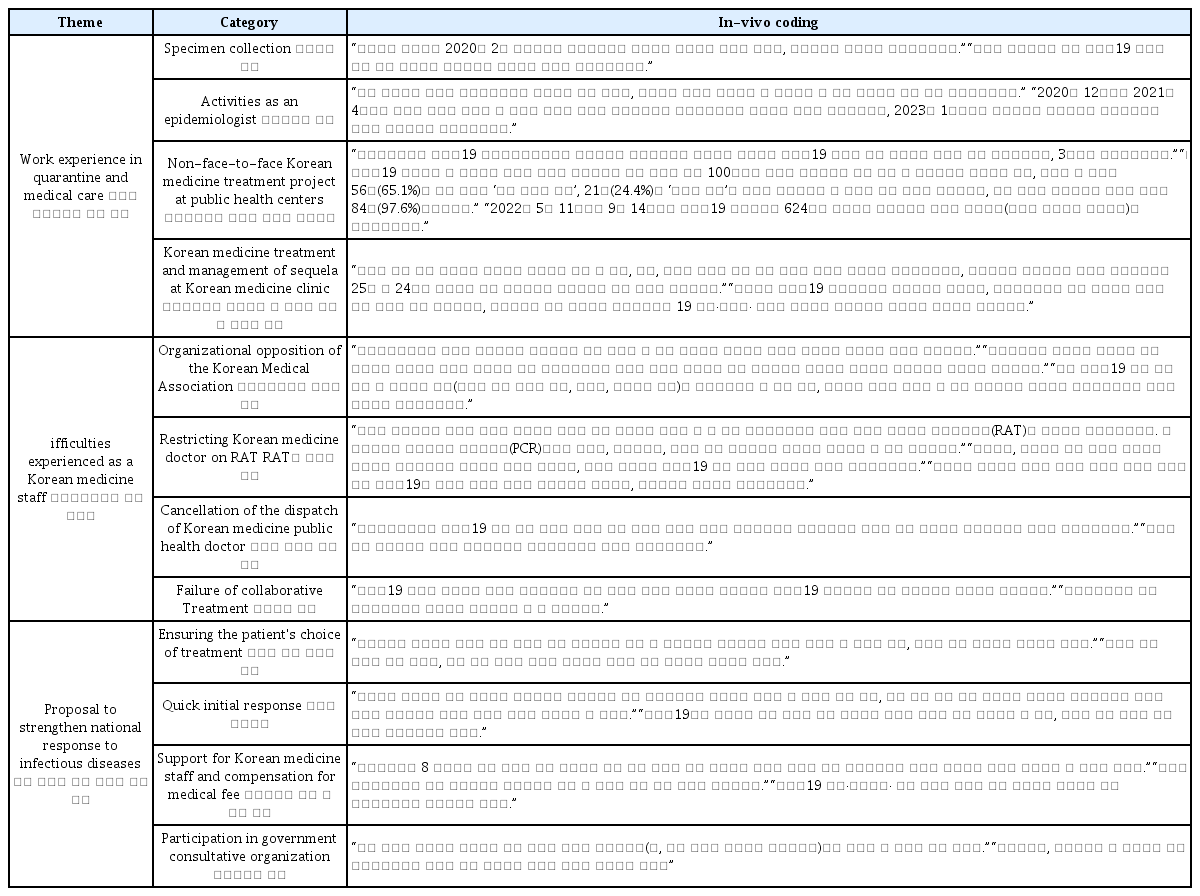| Work experience in quarantine and medical care 방역과 의료에서의 업무 경험 |
Specimen collection 검체채취 수행 |
“확진자가 폭발했던 2020년 2월 인천지역의 선별진료소에 파견되어 검체채취 업무를 간호사, 치과의사와 동일하게 수행하였습니다.”
“한의과 공보의들은 주로 코로나19 확진자 폭증 지역 중심으로 역학조사와 검체채취 업무에 참여하였습니다.” |
| Activities as an epidemiologist 역학조사관 활동 |
“제가 근무했던 지역의 역학조사관으로 투입되어 개별 확진자, 확진자와 접촉자 경로파악 및 동선관리 등 감염 위험요소 격리 업무 전담하였습니다.” “2020년 12월부터 2021년 4월까지 경기도 코로나 확진자 수 증가로 인하여 경기도 보건지소에서 역학조사관으로 투입되어 업무를 수행하였으며, 2023년 1월부터는 방역상황이 변경되면서 감염취약시설 위주로 역학조사를 진행하였습니다.” |
| Non-face-to-face Korean medicine treatment project at public health centers 보건소에서의 비대면 한의약 진료사업 |
“대한한의사협회 코로나19 한의진료접수센터의 진료지침과 운영가이드를 참고하여 보건소에 코로나19 환자에 대한 한의진료 사업을 직접 제안하였으며, 3개월간 운영하였습니다.”
“보건소에서 코로나19 감염증상 및 후유증상 비대면 한의약 진료사업을 통해 코로나 환자 100명에게 한약을 처방하였고 사업 종료 후 환자들에게 설문조사 결과, 참가자 중 과반인 56명(65.1%)이 건강 회복에 ‘매우 도움이 됐다’, 21명(24.4%)이 ‘도움이 됐다’고 응답해 전반적으로 큰 도움을 받은 것으로 나타났으며, 또한 한의약 진료사업에 만족한 환자는 84명(97.6%)이었습니다.” “2022년 5월 11일부터 9월 14일까지 코로나19 재택치료자 624명을 대상으로 보건소에서 비대면 한의진료(탕약과 보험급여 한약제제)를 실시하였습니다.” |
| Korean medicine treatment and management of sequela at Korean medicine clinic 한의원에서의 한의치료 및 후유증 관리 및 후유증 관리 |
“양약을 먹고 있던 환자들을 대상으로 한의진료 시행 시 발열, 오한, 인후통 등에서 호전 되어 진료에 만족한 환자들이 대부분이었으며, 한의원에서 자체적으로 시행한 설문조사에서 25명 중 24명이 앞으로도 다른 질병에서도 한의진료를 받고 싶다고 하였습니다.”
“의과에서 코로나19 경증환자에게 제공되었던 타이레놀, 아세트아미노펜 등의 해열제와 동등한 치료 효과를 내는 연교패독산, 형개연교산 등을 한의원에 방문한코로나 19 경증·무증상· 후유증 환자군에 처방하였고 환자들의 만족도가 높았습니다.” |
| ifficulties experienced as a Korean medicine staff 한의의료진으로 겪은 어려움 |
Organizational opposition of the Korean Medical Association 대한의사협회의 조직적 반대 |
“대한의사협회에서 한의사 검체채취가 불법이라는 항의 공문을 각 지역 보건소로 발송하여 한의과 공보의는 배제되는 경우가 많았습니다.”
“생활치료센터 백신접종 업무에는 의과 공보의만 투입되는 경우가 많았는데 이는 대한의사협회의 반대로 한의과 공보의는 주로 역학조사나 검체채취 보조적인 행정업무를 수행하게 되었습니다.”
“초기 코로나19 검사 오더 입력 및 검체채취 업무(의사직 공통 업무로 의사, 한의사, 치과의사 해당)를 수행하였으나 약 한달 뒤에, 한의사가 충분히 수행할 수 있는 업무임에도 불구하고 대한의사협회의 반대로 업무에서 배제되었습니다.” |
| Restricting Korean medicine doctor on RAT RAT에 한의사 제한 |
“의료는 기본적으로 진단과 치료를 포함하는 것으로 일반 국민들도 스스로 할 수 있는 자가진단키트와 비슷한 코로나 전문가용 신속항원검사(RAT)에 한의사는 제한되었습니다. 또 현장에서는 인력난으로 유전자증폭(PCR)검사를 간호사, 요양보호사, 공무원 등이 수행하는데 의료인인 한의사는 할 수가 없었습니다.”
“역학조사, 검체채취 등에 한의과 공보의를 제외하고 치과공보의만 투입하는 경우가 많았으며, 한의과 공보의는 코로나19 관련 업무에 배제하는 경우가 대다수였습니다.”
“한의사는 법적으로 감염병 대처에 참여할 책임과 의무가 있고 코로나19에 대처할 역량과 능력이 충분함에도 검체채취, 역학조사에 한의사는 배제되었습니다.” |
| Cancellation of the dispatch of Korean medicine public health doctor 한의과 공보의 파견 취소 |
“국립중앙의료원에 코로나19 신규 병상 의료인 배치에 대해 한의과 공보의 파견이 결정되었으나 대한의사협회 반발로 의과 공보의만 투입되었다는 결정을 통보받았습니다.”
“코로나 초기 대구지역에 파견을 지원하였으나 대한의사협회의 반대로 무산되었습니다.” |
| Failure of collaborative Treatment 협진진료 무산 |
“코로나19 초기에 검체채취 업무를 수행하였으나 이후 의과의 반발로 업무에서 제외되었고 코로나19 입원환자에 대한 협진진료도 시행되지 않았습니다.”
“감염병전문병원 지정 의료기관임에도 불구하고 협진진료는 할 수 없었습니다.” |
| Proposal to strengthen national response to infectious diseases 국가 감염병 대응 강화를 위한 제안 |
Ensuring the patient's choice of treatment 환자의 진료 선택권 보장 |
“국민들에게 한의치료 효과에 대한 홍보를 통해 신종감염병 발생 시 한의진료가 가능하다는 인식을 심어줄 수 있어야 하며, 환자의 진료 선택권을 보장해야 합니다.”
“감염병 확산 저지를 위해 한의사, 의사 모두 진단과 치료에 참여시켜 환자의 진료 선택권을 확대해야 합니다.” |
| Quick initial response 신속한 초기대응 |
“감염병은 전파력이 높아 신속성이 최우선으로 유증상자를 빨리 한의원에서도 진단하고 신고할 수 있도록 해야 하며, 격리 혹은 치료 등을 신속하게 결정해야 국가적으로도 감염병 전파를 차단하는데 도움이 된다는 사실을 간과하면 안 됩니다.”
“코로나19처럼 전파력이 높은 감염병 위기 앞에서는 한의와 양의를 결코 차별해선 안 되며, 초기에 가용 가능한 모든 자원을 총동원해야만 합니다.” |
| Support for Korean medicine staff and compensation for medical fee 한의의료진 지원 및 수가 보상 |
“한의의료진의 8 들코로나 환자 치료에 대한 수가지급 등에 대해 능동적 관심 필요하며 감염병 치료에 있어 초기단계부터 후유증 관리까지 협진이 이루어질 수 있어야 합니다.”
“코로나19 재택치료자들에 대한 한의치료의 본인부담금 지원 및 한의과 별도 수가 신설이 필요합니다.”
“코로나19 경증·재택치료· 백신 후유증 환자에 대한 한의진료 제도화를 통해 수가보상체계가 마련되어야 합니다.” |
| Participation in government consultative organization 정부협의체 참여 |
“한의 감염병 전문가를 육성하여 국가 주도의 감염병 전문가회의(예, 국가 감염병 위기대응 자문위원회)등에 참여할 수 있도록 해야 합니다.”
“보건복지부, 질병관리청 등 보건의료 관련 중앙행정기관에 감염병 관련 협의체에 한의사 참여를 요청해야 합니다” |








